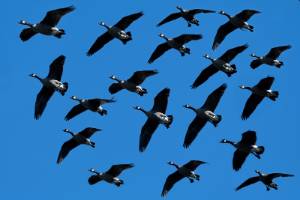Summary
This is the first lesson in a series called, “Survival.” In this lesson students will observe different groups of animal groups and why the animals form groups to survive.
Essential Question(s)
Why do animals live in groups?
Snapshot
Engage
Students begin an "I Used to Think ... But Now I Know" strategy to describe what they think about why animals live in groups.
Explore
Students watch videos of animals in groups and make observations about various animals' grouping behavior.
Explain
Students draw conclusions about the animal groups and share their observations with the class.
Extend
Students compare animals that live in groups to those that live in solitude.
Evaluate
Students review the essential question and revise their previous thinking, completing the "I Used to Think ... But Now I Know" activity.
Materials
Survival Group Discovery Lab Handout
I Used to Think, Now I Know Handout
Internet-enabled device(s) to watch videos about animal groups
Engage
Introduce the I Used to Think ... But Now I Know strategy and pass out the accompanying student handout (attached). Ask students, “Why do animals live in groups?” Have them respond in the “I Used to Think” column. After students have completed this portion of the assignment, have them put the paper aside. Let them know they will return to it at the end of the lesson.
Explore
In small groups, assign students to observe one of the following videos about animal groups (links can be found below and the full URL for each video is listed in the Resources at the end of the lesson):
Bees (video link here)
Wolves (video link here)
Birds (video link here)
Zebras (video link here)
Fish (video link here)
Pass out the attached Survival Groups Discovery Lab handout. Using this tool, students will answer the following questions about one or more of the animal groups:
About how big is the group?
Why do these animals live in a group?
What roles do the members play?
What are the benefits of the group?
What are the risks of the group?
What other things do you notice and wonder?
Explain
Have each group share out their observations about one of the animal groups, based. After each presentation, have students use a Think-Pair-Share strategy to answer the question, "Why does THIS animal live in a group?"
Help students make the connections and discover that animals live in groups to help the members of the group survive.
Extend
Have students compare animals that live alone and those that live in groups. Watch this short Kratt’s Creatures video (full URL listed below) that talks about animals that live in solitude. After watching the video, lead a group discussion having students compare animals that live in groups to animals that live in solitude.
Evaluate
In addition to the artifact from the Extend, have students complete the “I Used to Think ... Now I Know” activity by answering the following question on the “But Now I Know” side: Why do animals live in groups? Students should support their claims with details from the lesson.
Resources
K20 Center. (n.d.). I used to think . . . but now I know. Strategies. Retrieved from https://learn.k20center.ou.edu/strategy/d9908066f654727934df7bf4f50639f2
K20 Center. (n.d.). Think-pair-share. Strategies. Retrieved from https://learn.k20center.ou.edu/strategy/d9908066f654727934df7bf4f5064b49
PBS. (2007, October 23). NATURE | Silence of the Bees | Inside the Hive | PBS. Retrieved from https://www.youtube.com/watch?v=lE-8QuBDkkw
PBS, N. O. (2018, January 05). Wolf Pack Teams Up to Fight Off Intruder. Retrieved from https://www.youtube.com/watch?v=VcTsWXOZMzQ
Planet, A. (2008, September 16). Fooled by Nature - Zebra's Stripe. Retrieved from https://www.youtube.com/watch?v=IISNFkRkSxI
Productions, J. D. (2012, January 11). ULTIMATE MURMURATION - PEREGRINE HUNTS STARLINGS IN ROME - EARTHFLIGHT. Retrieved from https://www.youtube.com/watch?v=V-mCuFYfJdI
Rangers, E. (2012, July 25). School of Fish. Retrieved from https://www.youtube.com/watch?v=su1en9Vxpog
Solitary on the African Savannah: Kratts Creatures. (2019, July 08). Retrieved from https://ninenet.pbslearningmedia.org/resource/48130444-f7c3-4766-820e-66297b2d64bc/48130444-f7c3-4766-820e-66297b2d64bc/


